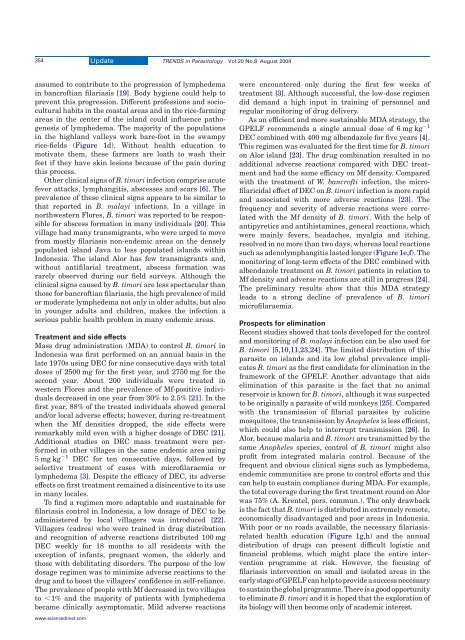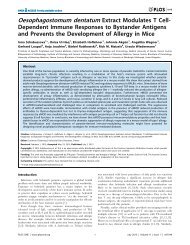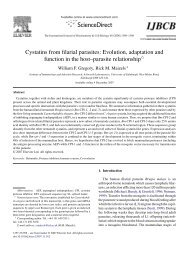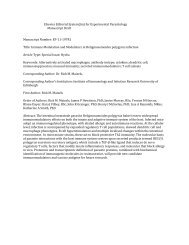Lymphatic filariasis and Brugia timori - Rick Maizels' Group ...
Lymphatic filariasis and Brugia timori - Rick Maizels' Group ...
Lymphatic filariasis and Brugia timori - Rick Maizels' Group ...
Create successful ePaper yourself
Turn your PDF publications into a flip-book with our unique Google optimized e-Paper software.
354<br />
assumed to contribute to the progression of lymphedema<br />
in bancroftian <strong>filariasis</strong> [19]. Body hygiene could help to<br />
prevent this progression. Different professions <strong>and</strong> sociocultural<br />
habits in the coastal areas <strong>and</strong> in the rice-farming<br />
areas in the center of the isl<strong>and</strong> could influence pathogenesis<br />
of lymphedema. The majority of the populations<br />
in the highl<strong>and</strong> valleys work bare-foot in the swampy<br />
rice-fields (Figure 1d). Without health education to<br />
motivate them, these farmers are loath to wash their<br />
feet if they have skin lesions because of the pain during<br />
this process.<br />
Other clinical signs of B. <strong>timori</strong> infection comprise acute<br />
fever attacks, lymphangitis, abscesses <strong>and</strong> scars [6]. The<br />
prevalence of these clinical signs appears to be similar to<br />
that reported in B. malayi infections. In a village in<br />
northwestern Flores, B. <strong>timori</strong> was reported to be responsible<br />
for abscess formation in many individuals [20]. This<br />
village had many transmigrants, who were urged to move<br />
from mostly <strong>filariasis</strong> non-endemic areas on the densely<br />
populated isl<strong>and</strong> Java to less populated isl<strong>and</strong>s within<br />
Indonesia. The isl<strong>and</strong> Alor has few transmigrants <strong>and</strong>,<br />
without antifilarial treatment, abscess formation was<br />
rarely observed during our field surveys. Although the<br />
clinical signs caused by B. <strong>timori</strong> are less spectacular than<br />
those for bancroftian <strong>filariasis</strong>, the high prevalence of mild<br />
or moderate lymphedema not only in older adults, but also<br />
in younger adults <strong>and</strong> children, makes the infection a<br />
serious public health problem in many endemic areas.<br />
Treatment <strong>and</strong> side effects<br />
Mass drug administration (MDA) to control B. <strong>timori</strong> in<br />
Indonesia was first performed on an annual basis in the<br />
late 1970s using DEC for nine consecutive days with total<br />
doses of 2500 mg for the first year, <strong>and</strong> 2750 mg for the<br />
second year. About 200 individuals were treated in<br />
western Flores <strong>and</strong> the prevalence of Mf-positive individuals<br />
decreased in one year from 30% to 2.5% [21]. In the<br />
first year, 88% of the treated individuals showed general<br />
<strong>and</strong>/or local adverse effects; however, during re-treatment<br />
when the Mf densities dropped, the side effects were<br />
remarkably mild even with a higher dosage of DEC [21].<br />
Additional studies on DEC mass treatment were performed<br />
in other villages in the same endemic area using<br />
5mgkg 21 DEC for ten consecutive days, followed by<br />
selective treatment of cases with microfilaraemia or<br />
lymphedema [3]. Despite the efficacy of DEC, its adverse<br />
effects on first treatment remained a disincentive to its use<br />
in many locales.<br />
To find a regimen more adaptable <strong>and</strong> sustainable for<br />
<strong>filariasis</strong> control in Indonesia, a low dosage of DEC to be<br />
administered by local villagers was introduced [22].<br />
Villagers (cadres) who were trained in drug distribution<br />
<strong>and</strong> recognition of adverse reactions distributed 100 mg<br />
DEC weekly for 18 months to all residents with the<br />
exception of infants, pregnant women, the elderly <strong>and</strong><br />
those with debilitating disorders. The purpose of the low<br />
dosage regimen was to minimize adverse reactions to the<br />
drug <strong>and</strong> to boost the villagers’ confidence in self-reliance.<br />
The prevalence of people with Mf decreased in two villages<br />
to ,1% <strong>and</strong> the majority of patients with lymphedema<br />
became clinically asymptomatic. Mild adverse reactions<br />
www.sciencedirect.com<br />
Update TRENDS in Parasitology Vol.20 No.8 August 2004<br />
were encountered only during the first few weeks of<br />
treatment [3]. Although successful, the low-dose regimen<br />
did dem<strong>and</strong> a high input in training of personnel <strong>and</strong><br />
regular monitoring of drug delivery.<br />
As an efficient <strong>and</strong> more sustainable MDA strategy, the<br />
GPELF recommends a single annual dose of 6 mg kg 21<br />
DEC combined with 400 mg albendazole for five years [4].<br />
This regimen was evaluated for the first time for B. <strong>timori</strong><br />
on Alor isl<strong>and</strong> [23]. The drug combination resulted in no<br />
additional adverse reactions compared with DEC treatment<br />
<strong>and</strong> had the same efficacy on Mf density. Compared<br />
with the treatment of W. bancrofti infection, the microfilaricidal<br />
effect of DEC on B. <strong>timori</strong> infection is more rapid<br />
<strong>and</strong> associated with more adverse reactions [23]. The<br />
frequency <strong>and</strong> severity of adverse reactions were correlated<br />
with the Mf density of B. <strong>timori</strong>. With the help of<br />
antipyretics <strong>and</strong> antihistamines, general reactions, which<br />
were mainly fevers, headaches, myalgia <strong>and</strong> itching,<br />
resolved in no more than two days, whereas local reactions<br />
such as adenolymphangitis lasted longer (Figure 1e,f). The<br />
monitoring of long-term effects of the DEC combined with<br />
albendazole treatment on B. <strong>timori</strong> patients in relation to<br />
Mf density <strong>and</strong> adverse reactions are still in progress [24].<br />
The preliminary results show that this MDA strategy<br />
leads to a strong decline of prevalence of B. <strong>timori</strong><br />
microfilaraemia.<br />
Prospects for elimination<br />
Recent studies showed that tools developed for the control<br />
<strong>and</strong> monitoring of B. malayi infection can be also used for<br />
B. <strong>timori</strong> [5,10,11,23,24]. The limited distribution of this<br />
parasite on isl<strong>and</strong>s <strong>and</strong> its low global prevalence implicates<br />
B. <strong>timori</strong> as the first c<strong>and</strong>idate for elimination in the<br />
framework of the GPELF. Another advantage that aids<br />
elimination of this parasite is the fact that no animal<br />
reservoir is known for B. <strong>timori</strong>, although it was suspected<br />
to be originally a parasite of wild monkeys [25]. Compared<br />
with the transmission of filarial parasites by culicine<br />
mosquitoes, the transmission by Anopheles is less efficient,<br />
which could also help to interrupt transmission [26]. In<br />
Alor, because malaria <strong>and</strong> B. <strong>timori</strong> are transmitted by the<br />
same Anopheles species, control of B. <strong>timori</strong> might also<br />
profit from integrated malaria control. Because of the<br />
frequent <strong>and</strong> obvious clinical signs such as lymphedema,<br />
endemic communities are prone to control efforts <strong>and</strong> this<br />
can help to sustain compliance during MDA. For example,<br />
the total coverage during the first treatment round on Alor<br />
was 75% (A. Krentel, pers. commun.). The only drawback<br />
is the fact that B. <strong>timori</strong> is distributed in extremely remote,<br />
economically disadvantaged <strong>and</strong> poor areas in Indonesia.<br />
With poor or no roads available, the necessary <strong>filariasis</strong>related<br />
health education (Figure 1g,h) <strong>and</strong> the annual<br />
distribution of drugs can present difficult logistic <strong>and</strong><br />
financial problems, which might place the entire intervention<br />
programme at risk. However, the focusing of<br />
<strong>filariasis</strong> intervention on small <strong>and</strong> isolated areas in the<br />
early stage of GPELF can help to provide a success necessary<br />
tosustainthe globalprogramme. Thereisagood opportunity<br />
to eliminate B. <strong>timori</strong> <strong>and</strong> it is hoped that the exploration of<br />
its biology will then become only of academic interest.





